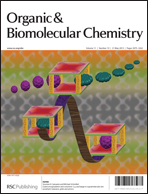Subtle “supramolecular buttressing effects” in Cucurbit[7]uril/guest assemblies†
Abstract
Biphenyl derivatives bearing a dimethylsulfonium group at position 3 and three different substituents at position 4 (H, F and CH3) have been prepared as probes to test the validity of the “supramolecular buttressing” concept. We define the latter as the alteration, by a neighboring unit, of a substituent effect on intermolecular recognition. In this case, the 4-substituents exert some pressure on the 3-dimethylsulfonium groups and control the ratio of their syn and anti conformations. As free species, biphenyls bearing 4-H and 4-F substituents are present as approximately equimolar mixtures of syn and anti-conformers, while the biphenyl scaffold with a 4-CH3 group adopts the anti-conformation exclusively. The 3-dimethylsulfonium substituents then interact with one of the carbonylated portals of Cucurbit[7]uril (CB[7]), and their conformations affect the position of the guests inside the cavity of the macrocycle, thereby validating our “supramolecular buttressing” model. Surprisingly however, binding affinities towards CB[7] are barely affected by the nature of the 4-substituents and the conformations of the neighboring sulfonium groups, despite very different electronic densities presented to the CB[7] portal in their syn or anti conformations. Solvation was found to dramatically smoothen host–guest Columbic interactions, although the latter remain important in the recognition process. Replacing the positively charged 3-dimethylsulfonium unit with an isopropyl substituent decreases the affinity of the biphenyl guest by 1000-fold.
![Graphical abstract: Subtle “supramolecular buttressing effects” in Cucurbit[7]uril/guest assemblies](/en/Image/Get?imageInfo.ImageType=GA&imageInfo.ImageIdentifier.ManuscriptID=C3OB40250A&imageInfo.ImageIdentifier.Year=2013)
- This article is part of the themed collection: In Celebration of Andrew D. Hamilton’s Career in Chemistry

 Please wait while we load your content...
Please wait while we load your content...